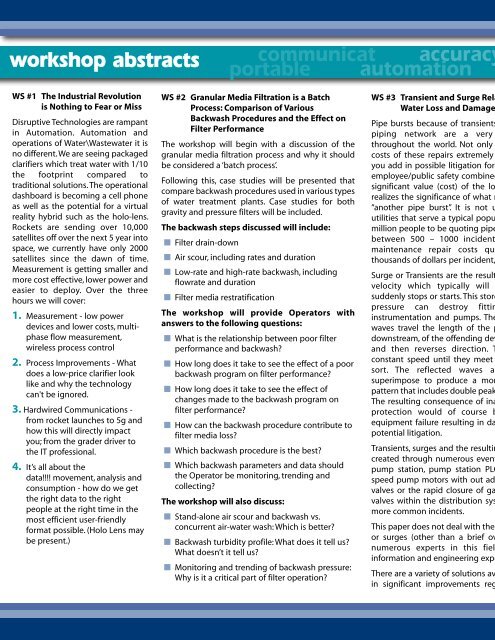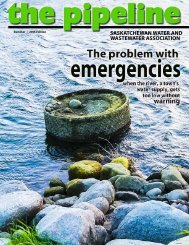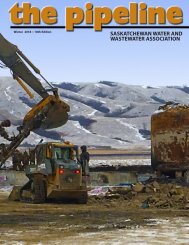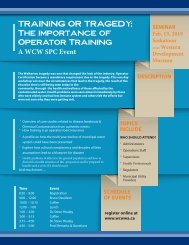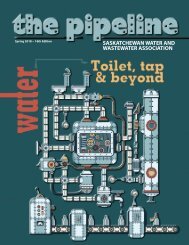2019 Fall Newsletter
Create successful ePaper yourself
Turn your PDF publications into a flip-book with our unique Google optimized e-Paper software.
workshop abstracts<br />
communicat accuracy<br />
portable automation<br />
processes<br />
meter<br />
consumption treatment<br />
efficient meter<br />
control<br />
training<br />
service<br />
WS #1 The Industrial Revolution<br />
is Nothing to Fear or Miss<br />
Disruptive Technologies are rampant<br />
in Automation. Automation and<br />
operations of Water\Wastewater it is<br />
no different. We are seeing packaged<br />
clarifiers which treat water with 1/10<br />
the footprint compared to<br />
traditional solutions. The operational<br />
dashboard is becoming a cell phone<br />
as well as the potential for a virtual<br />
reality hybrid such as the holo-lens.<br />
Rockets are sending over 10,000<br />
satellites off over the next 5 year into<br />
space, we currently have only 2000<br />
satellites since the dawn of time.<br />
Measurement is getting smaller and<br />
more cost effective, lower power and<br />
easier to deploy. Over the three<br />
hours we will cover:<br />
1. Measurement - low power<br />
devices and lower costs, multiphase<br />
flow measurement,<br />
wireless process control<br />
2. Process Improvements - What<br />
does a low-price clarifier look<br />
like and why the technology<br />
can't be ignored.<br />
3. Hardwired Communications -<br />
from rocket launches to 5g and<br />
how this will directly impact<br />
you; from the grader driver to<br />
the IT professional.<br />
4. It’s all about the<br />
data!!!! movement, analysis and<br />
consumption - how do we get<br />
the right data to the right<br />
people at the right time in the<br />
most efficient user-friendly<br />
format possible. (Holo Lens may<br />
be present.)<br />
WS #2 Granular Media Filtration is a Batch<br />
Process: Comparison of Various<br />
Backwash Procedures and the Effect on<br />
Filter Performance<br />
The workshop will begin with a discussion of the<br />
granular media filtration process and why it should<br />
be considered a ‘batch process’.<br />
Following this, case studies will be presented that<br />
compare backwash procedures used in various types<br />
of water treatment plants. Case studies for both<br />
gravity and pressure filters will be included.<br />
The backwash steps discussed will include:<br />
n Filter drain-down<br />
n Air scour, including rates and duration<br />
n Low-rate and high-rate backwash, including<br />
flowrate and duration<br />
n Filter media restratification<br />
The workshop will provide Operators with<br />
answers to the following questions:<br />
n What is the relationship between poor filter<br />
performance and backwash?<br />
n How long does it take to see the effect of a poor<br />
backwash program on filter performance?<br />
n How long does it take to see the effect of<br />
changes made to the backwash program on<br />
filter performance?<br />
n How can the backwash procedure contribute to<br />
filter media loss?<br />
n Which backwash procedure is the best?<br />
n Which backwash parameters and data should<br />
the Operator be monitoring, trending and<br />
collecting?<br />
The workshop will also discuss:<br />
n Stand-alone air scour and backwash vs.<br />
concurrent air-water wash: Which is better?<br />
n Backwash turbidity profile: What does it tell us?<br />
What doesn’t it tell us?<br />
n Monitoring and trending of backwash pressure:<br />
Why is it a critical part of filter operation?<br />
WS #3 Transient and Surge Related Pipe Bursts,<br />
Water Loss and Damage Prevention<br />
Pipe bursts because of transients and surges within a<br />
piping network are a very common problem<br />
throughout the world. Not only are the maintenance<br />
costs of these repairs extremely expensive, but when<br />
you add in possible litigation for third party damages,<br />
employee/public safety combined with the potentially<br />
significant value (cost) of the lost water, one quickly<br />
realizes the significance of what may appear simply as<br />
“another pipe burst”. It is not uncommon for water<br />
utilities that serve a typical population base of 1 – 1.5<br />
million people to be quoting pipe burst occurrences of<br />
between 500 – 1000 incidents per year. To hear<br />
maintenance repair costs quoted at potentially<br />
thousands of dollars per incident, is not uncommon.<br />
Surge or Transients are the result of a rapid change in<br />
velocity which typically will happen when flow<br />
suddenly stops or starts. This stored energy, released as<br />
pressure can destroy fittings, pipes, valves,<br />
instrumentation and pumps. The associated pressure<br />
waves travel the length of the pipeline, upstream or<br />
downstream, of the offending device (pump, valve, etc)<br />
and then reverses direction. The waves move at<br />
constant speed until they meet a boundary of some<br />
sort. The reflected waves and incident waves<br />
superimpose to produce a more complicated wave<br />
pattern that includes double peaks and double troughs.<br />
The resulting consequence of inattention or improper<br />
protection would of course be a pipe burst or<br />
equipment failure resulting in damage, lost water and<br />
potential litigation.<br />
Transients, surges and the resulting pipe bursts can be<br />
created through numerous events. Loss of power at a<br />
pump station, pump station PLC malfunction, single<br />
speed pump motors with out adequate pump control<br />
valves or the rapid closure of gate valves or butterfly<br />
valves within the distribution system are a few of the<br />
more common incidents.<br />
This paper does not deal with the analyses of transients<br />
or surges (other than a brief overview) as there are<br />
numerous experts in this field and a wealth of<br />
information and engineering expertise available.<br />
There are a variety of solutions available that can result<br />
in significant improvements regarding the numbers<br />
and frequency of pipe bursts within a water utilities<br />
distribution or transmission system. This paper will<br />
focus on the following solutions complete with a brief<br />
explanation of the application and the intricacies of the<br />
associated equipment. An overview will be given of non<br />
– diaphragm operated control valve solutions complete<br />
with history and advantages and disadvantages.<br />
Non – Diaphragm Operated Control Valve Solutions<br />
n Rupture Discs/Burst Discs<br />
n Surge Tanks or Surge Drums<br />
The core paper will focus on pressure relief diaphragm<br />
operated control valve solutions and the resulting<br />
benefits, while taking the mystery out of the selection<br />
process and variety of options.<br />
Diaphragm Operated Control Valve Solutions<br />
n Pressure Relief Valve<br />
n Surge Anticipating Relief Valve<br />
n Surge Anticipating on Rate of Rise Relief Valve<br />
n Surge Anticipating Relief Valve (electrically timed to<br />
low pressure reading or power failure at pumps)<br />
n Electronic Control to respond to any out of limit<br />
signal<br />
Diaphragm Operated Pump Control Valves will be<br />
briefly included in this paper for consideration where<br />
pumps operating with single speed motors are utilized.<br />
Pumps that operate utilizing modern VFD (variable<br />
frequency drive) motors will not typically require<br />
diaphragm operated pump control valves for normal<br />
service but will most definitely require careful review<br />
and selection of appropriate pressure relief valve<br />
protection for power failure incidents<br />
The paper will describe a variety of situations while<br />
citing examples of transients/surges and the resulting<br />
damage. The above solutions will be reviewed, while<br />
discussing the key advantages and disadvantages of<br />
each method of Pressure Relief as well as key<br />
application information and examples of a variety of<br />
successful applications. The paper will clearly present a<br />
variety of pressure relief options for water utilities and<br />
educate interested parties on the overall reduction of<br />
pipe bursts and the associated costs combined with the<br />
corresponding savings in water.<br />
WS #4 Distribution Maintenance<br />
Topics to Cover<br />
n Fire Hydrants – Inspections & Repairs<br />
n Water Main Valves<br />
n Unidirectional Flushing of the Water Mains<br />
n Leak Detection<br />
n Water Meters & Testing<br />
WS #5 Achieving Safety, Performance<br />
Optimization and Overview of an<br />
Engineered Chemical Feed System<br />
Many public water utilities have a growing<br />
awareness for safety and performance<br />
optimization when it comes to their chemical<br />
feed. Understanding how an engineered<br />
chemical feed system operates and how every<br />
component on the system contributes to safety<br />
and process optimization is important.<br />
Main focus points of ProMinent Fluid Controls<br />
Ltd. presentation will be:<br />
n General overview of an engineered<br />
chemical feed system<br />
n Advantages of using an engineered<br />
chemical feed system versus a standalone<br />
metering pump, focusing on the categories<br />
below:<br />
n Safety<br />
n Performance optimization<br />
n Maintenance<br />
n Best practices used when installing an<br />
engineered chemical feed system.<br />
WS #6 Multiple Pathways to Resiliency<br />
Increased resilience does not fall under the<br />
purview of a single organization and does not<br />
exist as a single point on the horizon. The<br />
emergency management version of resilience<br />
is achieved through the strategic and effective<br />
coordination of multiple organizations within a<br />
community and multiple communities within a<br />
province. The presentation will describe the<br />
Saskatchewan Public Safety Divisions vision of<br />
a multiple pathway to resilience strategy.<br />
WS #7 Chad Hymus see keynote information


